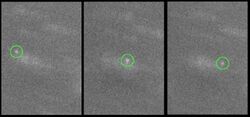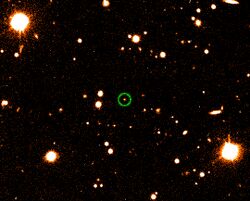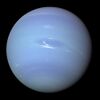Astronomy:Halimede (moon)
 Set of stacked discovery images from August 2003, showing Halimede among trailed stars | |
| Discovery[1][2] | |
|---|---|
| Discovered by |
|
| Discovery date | August 14, 2002 |
| Designations | |
Designation | Neptune IX |
| Pronunciation | /hæləˈmiːdiː/[3] |
| Named after | Ἁλιμήδη Halimēdē |
| S/2002 N 1 | |
| Adjectives | Halimedean /ˌhæləməˈdiːən/ |
| Orbital characteristics[4] | |
| Epoch June 10, 2003 | |
| 16,611,000 km | |
| Eccentricity | 0.2646 |
| Orbital period | 1879.08 d (5.14 a) |
| Inclination | 134.1° |
| Physical characteristics | |
| Mean diameter | 62 km (for albedo 0.04)[5] |
| Albedo | 0.04 (assumed)[5] |
Spectral type | neutral (grey) B-V=0.73 R-V=0.35[6] |
Halimede /hæləˈmiːdiː/, or Neptune IX, is a retrograde irregular satellite of Neptune. It was discovered by Matthew J. Holman, John J. Kavelaars, Tommy Grav, Wesley C. Fraser and Dan Milisavljevic on August 14, 2002.[7]
Name

Halimede, like many of the outer satellites of Neptune, is named after one of the Nereids, the fifty daughters of Nereus and Doris. Before the announcement of its name on February 3, 2007 (IAUC 8802), Halimede was known by the provisional designation S/2002 N 1.
Orbit

Halimede has the second most eccentric and third most inclined orbit around Neptune.[8] This is illustrated on the diagram in relation to other irregular satellites of Neptune. The satellites above the horizontal axis are prograde, the satellites beneath it are retrograde. The yellow segments extend from the pericentre to the apocentre, showing the eccentricity. It is also worth mentioning that Sao and Laomedeia are similar to Halimede but they both have prograde orbits unlike Halimede which has a retrograde orbit.[9]
Physical characteristics
Halimede is about 62 kilometers in diameter (assuming an albedo of 0.04)[5] and appears neutral (grey) in the visible light. Given the very similar colour of the satellite to that of Nereid together with the high probability (41%[7]) of collision in the past lifespan of the Solar System, it has been suggested that the satellite could be a fragment of Nereid.[6]
References
- ↑ JPL (2011-07-21). "Planetary Satellite Discovery Circumstances". Jet Propulsion Laboratory. http://ssd.jpl.nasa.gov/?sat_discovery.
- ↑ Green, Daniel W. E. (January 13, 2003). "Satellites of Neptune". IAU Circular 8047. http://www.cbat.eps.harvard.edu/iauc/08000/08047.html. Retrieved 2011-10-24.
- ↑ Noah Webster (1884) A Practical Dictionary of the English Language
- ↑ Jacobson, R. A. (2008). "NEP078 – JPL satellite ephemeris". Planetary Satellite Mean Orbital Parameters. http://ssd.jpl.nasa.gov/?sat_elem.
- ↑ 5.0 5.1 5.2 Sheppard, Scott S.; Jewitt, David C.; Kleyna, Jan (2006). "A Survey for "Normal" Irregular Satellites around Neptune: Limits to Completeness". The Astronomical Journal 132 (1): 171–176. doi:10.1086/504799. Bibcode: 2006AJ....132..171S.
- ↑ 6.0 6.1 Grav, Tommy; Holman, Matthew J.; Fraser, Wesley C. (2004-09-20). "Photometry of Irregular Satellites of Uranus and Neptune". The Astrophysical Journal 613 (1): L77–L80. doi:10.1086/424997. Bibcode: 2004ApJ...613L..77G.
- ↑ 7.0 7.1 Holman, M. J.; Kavelaars, J. J.; Grav, T. et al. (2004). "Discovery of five irregular moons of Neptune". Nature 430 (7002): 865–867. doi:10.1038/nature02832. PMID 15318214. Bibcode: 2004Natur.430..865H. https://www.cfa.harvard.edu/~mholman/nature_final.pdf. Retrieved 24 October 2011.
- ↑ Williams, Dr. David R. (2008-01-22). "Neptunian Satellite Fact Sheet". NASA (National Space Science Data Center). http://nssdc.gsfc.nasa.gov/planetary/factsheet/neptuniansatfact.html.
- ↑ "In Depth | Halimede". https://solarsystem.nasa.gov/moons/neptune-moons/halimede/in-depth.
External links
- Matthew Holman's Neptune's page
- David Jewitt's pages
- Neptune's Known Satellites (by Scott S. Sheppard)
- MPC: Natural Satellites Ephemeris Service
- Mean orbital parameters from JPL
 |


